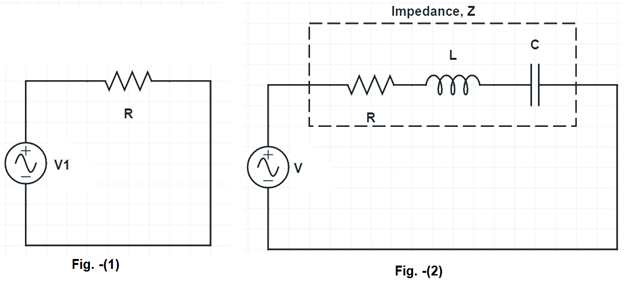The main difference between Resistance and Impedance is that resistance opposes the flow of DC & AC current whereas Impedance only opposes the flow of AC current. Impedance is having meaning only in AC circuit. It does not have any meaning in DC circuit.
Another major difference between resistance and impedance is that impedance may be combination of resistance, inductive reactance and or capacitance reactance. Whereas resistance simply means resistance of a component.
Some of the key differences between resistance and impedance is tabulated below.
| Resistance | Impedance |
| Resistance is an electrical circuit element which opposes the flow of current. The current may be AC as well as DC. Irrespective of current type, resistance opposes the flow of current. | Impedance is a collective name of a combination of resistance and or inductive reactance and or capacitive reactance. This means, a combination of resistance & inductive reactance or inductive reactance & capacitive reactance or capacitive reactance & resistance or resistance, inductive reactance & capacitive reactance is called impedance. |
| It is denoted by R. | It is denoted by symbol Z. |
| The value of resistance is independent of supply frequency. | The value of impedance depends on the supply frequency. |
| Two or more resistances are added arithmetically. This means, if two resistances are R1 and R2 then total resistance will be (R1+R2). | We cannot add two or more impedances arithmetically. Tow or more impedances are added vectorially. |
| The current through a resistance is always in phase with the voltage across it. | There is a phase difference between the current through impedance and voltage across it. The magnitude of phase difference depends on the presence of inductance and or capacitance in the impedance. |
| No operator is required to represent resistance. It is just written as scalar. | An operator called “j” operator is used to represent an impedance. This “j” operator when multiplied with any vector, rotates it by 90 degree in anti-clockwise direction. |
| Resistance is simply a real value. For example, it can be 8.5 Ω, 20 Ω and so. | Impedance is a complex quantity and hence it has real part as well as imaginary part. Real part correspond to presence of resistance in impedance and imaginary part corresponds to reactance part. Thus, if Z is impedance of an AC circuit, the Re(Z) = R & Im(Z) = X (reactance). Thus, Z may be written as Z = (R + jX) |
| The phase difference between current and voltage is ZERO. | The value of phase difference between voltage and current is calculated from tanø = (X/R) if the impedance Z = R+jX. |
| Active power is consumed by resistance. | Active power is consumed by resistive part and reactive power is consumed by inductive part of impedance. However, capacitor is considered as reactive power generator. |
Let us consider two circuit (1) and (2) to better understand the difference between resistance and impedance.

In the first circuit, there is only one element R connected to AC source. This is resistance of the circuit. In general, in an AC circuit, the value of element which opposes the flow of current is called impedance. So, impedance for this circuit Z = R. Hence imaginary part of this impedance is zero.
In second circuit, current opposing elements are R, L and C and hence their combination, all together, is impedance. The value of impedance is given as Z = R + j(ωL-1/ωC) where jωL & (-j/ωC) are the inductive and capacitive reactance respectively. Since, ω = 2πf, hence impedance depends on the value of source frequency.